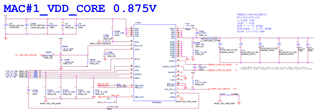Hi expert,
May I have your support to review customer schematic and clarify some questions that how to fill in the parameters in the spreadsheet?
Also, would you please correct if any mistakes and update to us to proper setting spreadsheet?
Here are some of their spec and used conditions.
Vout : 0.875V 12A
Fsw : 900kHz
Lo : 0.22uH
Co_POL:MLCC 47uF *10pcs + PSCAP 470uF *2 pcs
Co_Mac:MLCC 1617uf + PSCAP 470uF* 2pcs
Co_eff_total : 3200uF
Cin:22uF 25V 1206 X6S * 4pcs
Cin_eff:26.4 uF
Compensation code:10 ( seems fast response and lower overshoot & undershoot)
OCP:20A ( 20A/12A : 166% )
Soft-Start:3ms
Stand alone or multiphase :Stand alone
Q1: if using pinstrap compensation and there are 31 Comp. Code. For example, if customer choose comp. code = 10 and all below calculated value are green, is it typically correct for compensation?

Q2: what would be a recommended BW range for the loop compensation?
Q3: for the target Vo, is the R2G config correct? Cause they can't match value in the DS.
Q4: how to set PMBus address & interleave if using standalone? 0, auto or anything else?
Q5: MSEL2 (SS, OC, tracking) shows warning, could you please advise what might goes wrong?

TPS546B24A_3.3V_12A_ExcelCalculator_SchematicLayoutChecklist_20240111.xlsx
Thanks,
Allan

